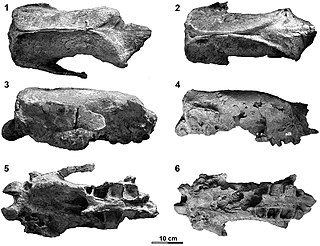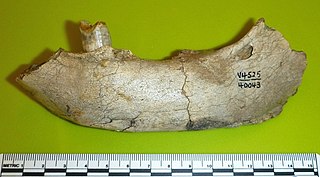
Purussaurus is an extinct genus of giant caiman that lived in South America during the Miocene epoch, from the Friasian to the Huayquerian in the SALMA classification. It is known from skull material found in the Brazilian and Peruvian Amazon, Colombian Villavieja Formation, Panamanian Culebra Formation, Urumaco and Socorro Formations of northern Venezuela.

Interatheriidae is an extinct family of notoungulate mammals from South America. Interatheriids are known from the Middle Eocene (Mustersan) to the Early Pleistocene (Uquian). These animals were principally small-sized, occupying a habitat like hares, marmots and viscachas. The majority were very small, like rodents.

Gryposuchus is an extinct genus of gavialid crocodilian. Fossils have been found from Argentina, Colombia, Venezuela, Brazil and the Peruvian Amazon. The genus existed during the Miocene epoch. One recently described species, G. croizati, grew to an estimated length of 10 metres (33 ft). Gryposuchus is the type genus of the subfamily Gryposuchinae, although a 2018 study indicates that Gryposuchinae and Gryposuchus might be paraphyletic and rather an evolutionary grade towards the gharial.

Xenastrapotherium is an extinct genus of astrapothere, a type of hoofed herbivorous mammal, native to South America, which lived in the Middle to Late Miocene period, typically during the Laventan stage. It is a member of the family Astrapotheriidae in the subfamily Uruguaytheriinae, large astrapotheres, equipped with a trunk-like nose and protruding teeth, similar to the elephants, but their tusks were the canine teeth, not the incisors. Xenastrapotherium was a genus widely distributed in northern South America, in contrast to other species of astrapotheres which lived in the area of the Southern Cone of the continent. It differed from other astrapotheres by having two lower incisors on each side of the jaw and the tusks have a pronounced longitudinal curvature, although their general shape and size are probably very similar to Astrapotherium, whose weight would be 900 to 1,500 kilograms, comparable to the current black rhinoceros.
Globidentosuchus is an extinct genus of basal caimanine crocodylian known from the late Middle to Late Miocene of the Middle and the Upper Members of the Urumaco Formation at Urumaco, Venezuela. Its skull was very short and robust, with large units of spherical teeth used to break the shells of molluscs as part of its durophagus diet. It is thought to be one of the most basal Caimanines, even sharing some traits with alligatorids.
Caiman brevirostris is an extinct species of caiman that lived during the Late Miocene, around 11.6 million years ago, to the end of the Miocene 5.3 million years ago in Acre and Amazonas, Brazil as well as Urumaco, Venezuela. Several specimens have been referred to the species, but only 3 of them are confidently placed in the species. C. brevirostris was originally named in 1987 on the basis of a single, incomplete rostrum with an associated mandibular ramus that had been found in Acre, Brazil. C. brevirostris is very distinct among Caiman species and caimaninae overall in that it preserves a characteristically short and robust skull that bears blunt posterior teeth that were built to break down harder foods. This was an adaption for durophagy, likely to crush shells of mollusks and clams which were common in the wetlands that C. brevirostris resided in.

Paedotherium is an extinct, potentially paraphyletic genus of Notoungulate, belonging to the family Hegetotheriidae, composed of small-sized, rodent or lagomorph-like South American ungulates. Four species are unambiguously recognized, from the Late Miocene to the Pleistocene of Argentina, and from the late Miocene of Bolivia and Chile.
Megadolodus is an extinct genus of proterotheriid litopterns.
Henricosbornia is an extinct genus of henricosborniid notoungulate that lived from the Late Paleocene to the Middle Eocene of what is now Argentina and Brazil.
Ethegotherium is an extinct genus of Notoungulates, belonging to the suborder Typotheria. It lived from the Lower to the Middle Miocene, and its fossilized remains were discovered in South America. It might be a synonym of the genus Prohegetotherium.
Propachyrucos is an extinct genus of hegetotheriid notoungulate. It lived from the Late Oligocene to the Early Miocene, in what is today South America.

Pseudoprepotherium is an extinct genus of sloths of the family Mylodontidae. It was widespread across northern South America during the Early to Late Miocene epoch around 21 to 5.3 million years ago. Fossils of the animal have been found in Brazil, Venezuela, and Peru. Pseudoprepotherium lived in a tropical climate with a water-rich environment. Their known remains are limited to limb bones, except for a few skulls and teeth. Based on these remains, they were most likely medium to large-sized mylodontid. The genus was described in 1961 and currently contains three species, which were originally assigned to the genus Prepotherium.

Periphragnis is an extinct genus of isotemnid notoungulates that lived from the Middle Eocene to the Early Oligocene in what is now Argentina and Chile.

Proeremotherium is an extinct genus of megatheriine ground sloths in the family Megatheriidae. It lived during the Late Miocene and Early Pliocene of what is now Venezuela. So far, two largely complete skulls have been recovered in the Falcón Basin in Venezuela. The finds identify the animals as medium-sized representatives of the Megatheriidae. In the cranial anatomy, Proeremotherium resembles the later and giant Eremotherium. It is therefore assumed that the two ground sloths are directly related to each other.
Archaeopithecus is an extinct genus of Notoungulate, belonging to the suborder Typotheria. It lived during the Middle Eocene, in what is today Argentina.
Altitypotherium is an extinct genus of Notoungulate, belonging to the suborder Typotheria. It lived during the Early Miocene, and its fossilized remains were discovered in South America.

Notopithecus is an extinct genus of Notoungulate, belonging to the suborder Typotheria. It lived from the Middle to the Late Eocene and its fossilized remains were discovered in South America.
Hegetotheriopsis is an extinct genus of hegetotheriid notoungulate. It lived from the Late Oligocene to the Early Miocene, and its fossilized remains are found in Argentina.
Bolivartherium is an extinct genus of mylodontine mylodontid sloth that lived during the Late Miocene and Late Pliocene in what is now Venezuela. Fossils have been found in the Codore and Urumaco Formations of Venezuela.

Magdalenabradys is an extinct genus of mylodontid ground sloths that lived during the Middle Miocene and Early Pliocene of what is now Colombia and Venezuela. Fossils have been found in the Villavieja Formation of the Honda Group in Colombia, and the Codore and Urumaco Formations of Venezuela.


















